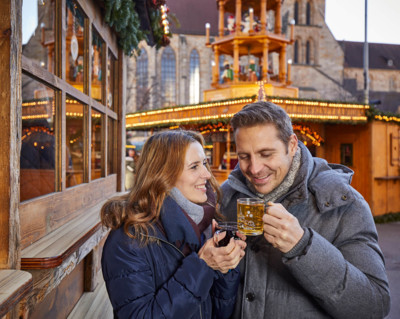Try out our favourite
Christmas Cookies
© TrickyTine/Christine Garcia Urbina
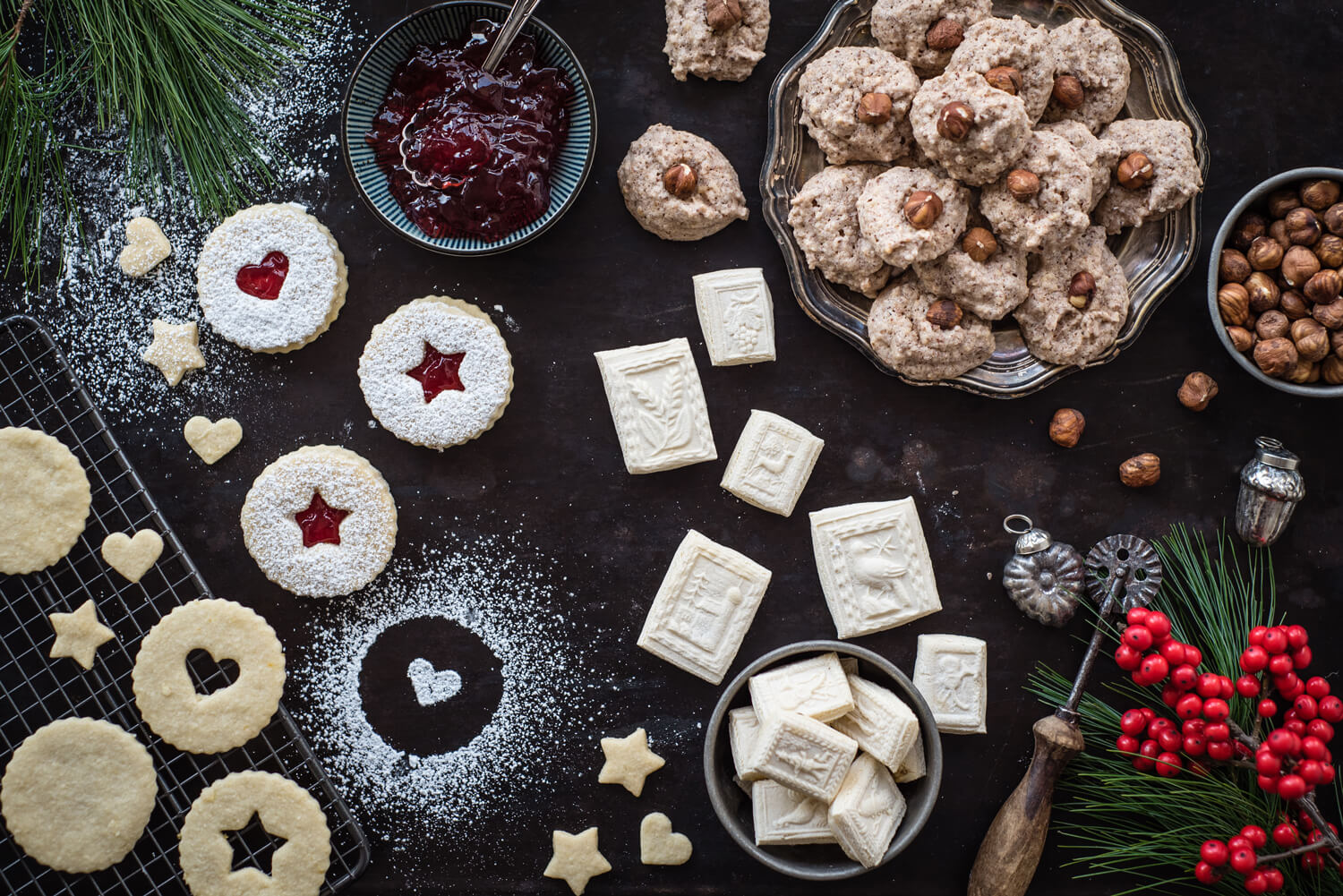

BW-Story
Sweet treats for the Christmas season
It is well-known that Baden-Württemberg is a great place for culinary delights. This is especially true during the Christmas season. In the winter months, the bakeries are very busy places: Kneading and shaping, rolling and cutting are the order of the day. And the sweet flavour of star anise and cinnamon wafts over everything.
We present five delicacies that are a must for the festive season in SouthWest Germany.
Spitzbuben
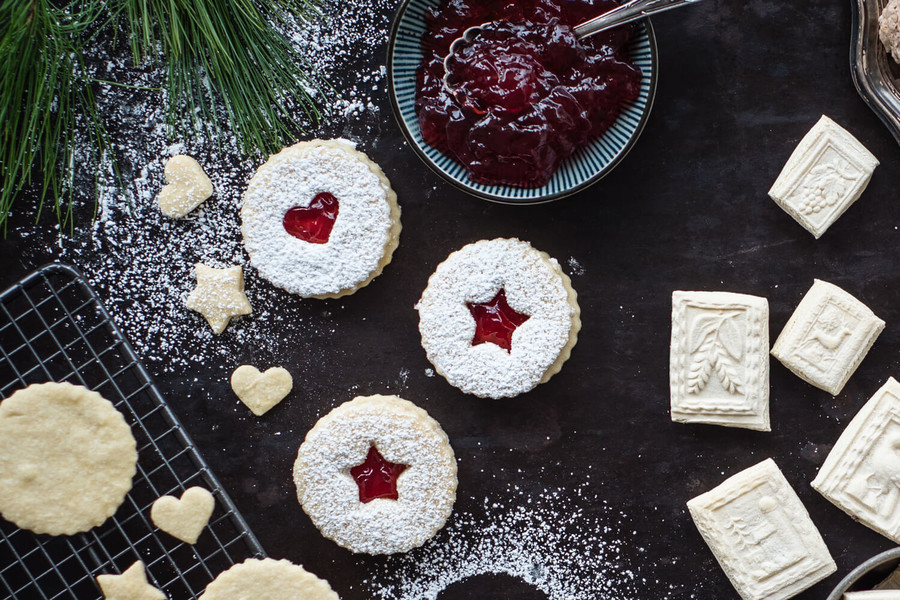
Spitzbuben are very popular in SouthWest Germany | © Trickytine/Christine Garcia Urbia
The Spitzbuben, also known as Hildabrötchen, have a long tradition. They originally come from southern Germany and are named after the Grand Duchess Hilda von Nassau, the last Grand Duchess of Baden.
Supposedly, the popular Grand Duchess enjoyed eating Hilda rolls and often baked them herself. She was buried at the side of her husband, Grand Duke Friedrich II, in the grand ducal grave chapel in Karlsruhe. Her ornate coffin can be viewed there.
Ingredients
- 1 cup sugar
- 2/3 cup of cold butter (cut into small pieces)
- 1 teaspoon vanilla extract
- 1 egg
- 1 1/3 cups of flour
- ½ cup of raspberry jam for the center
- 1 tbsp powdered sugar
Preparations
1. In a stand mixer, cream together sugar and butter. Add in the vanilla extract and egg until combined. Add in flour to form a dough. Shape the dough into a ball and wrap or cover well and put in the fridge for about an hour.
2. Preheat the oven to 325 Fahrenheit. Roll out the dough very thinly and cut out the cookies. Then cut out the shape you like (star/heart circle etc) in every other cookie and place all of them on a baking tray lined with baking paper and bake for about 15 minutes until golden.
3. After cooling down, heat the jelly, spread it over the cookies without the cutout, then place the cutout half on top of the cookie with the jam. Finally dust with powdered sugar for the seasonal look.
Springerle
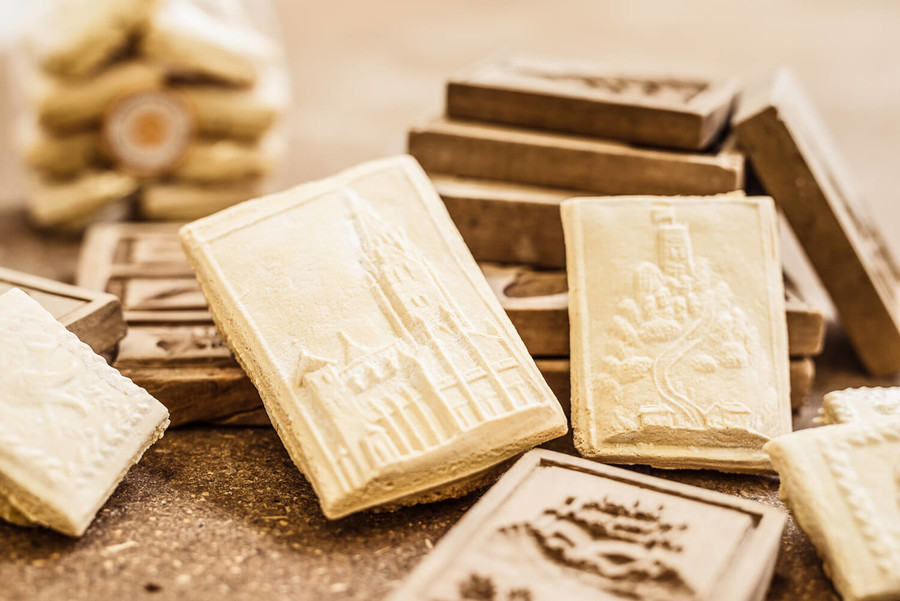
In SouthWest Germany, nothing says Christmas more than Springerle. These hard aniseed-flavoured biscuits can be eaten – but are also used as decoration in cafés, restaurants and even on Christmas trees! The dough is made of eggs, flour and sugar; wooden moulds, carved in medieval patterns, scenes and figures, create the traditional design. Moulds are sold in the Christmas markets and make a nice souvenir.
Ingredients
- 4 eggs
- 500 g / 2 ¼ cups powdered sugar
- 450 to 500g / 2 ¼ cup (dry) flour type 405 or spelled flour type 630
- 1 tablespoon of whole anis seed or if you like it can also be gingerbread, cardamom, ginger or similar
- Lightly toast the anise beforehand in a pan and then mix it into the batter. This treatment dissolves the essential oils and unfolds its full taste.
Preparations
1. All ingredients are placed in a warm room for several hours before starting.
2. Beat the eggs until frothy, then add the sifted powdered sugar and the tablespoon of anise seed.
3. Stir this mixture in the food processor for at least 10 minutes.
4. Then stir in the sifted flour, one tablespoon at a time.
5. The dough is now a bit soft and needs to rest to have time to shape.
6. Put the dough in a bowl with a tightly fitting lid and covered with cling wrap, leave to rest in the refrigerator for at least 12-24 hours.
7. When you are ready to make the cookies, you cut off a small portion of the dough and immediately cover the rest of the dough again, otherwise it will dry out.
8. Roll out the dough on the floured baking board 8-10 mm thick. Press the Springerle mold into the lightly powdered dough and cut out the springerle with a dough scraper, pastry wheel or a suitable cookie cutter.
9. Place the springerle on a baking sheet covered with aluminum foil and leave to dry for 24 hours in a warm place.
10. Preheat the oven to 140 degrees Celsius / 285 degrees Fahrenheit and bake the Springerle for approx. 15-18 minutes.
11. After baking, let the springerle cool, remove from the aluminum foil and store in a cardboard box in a damp place (balcony).
Hutzelbrot
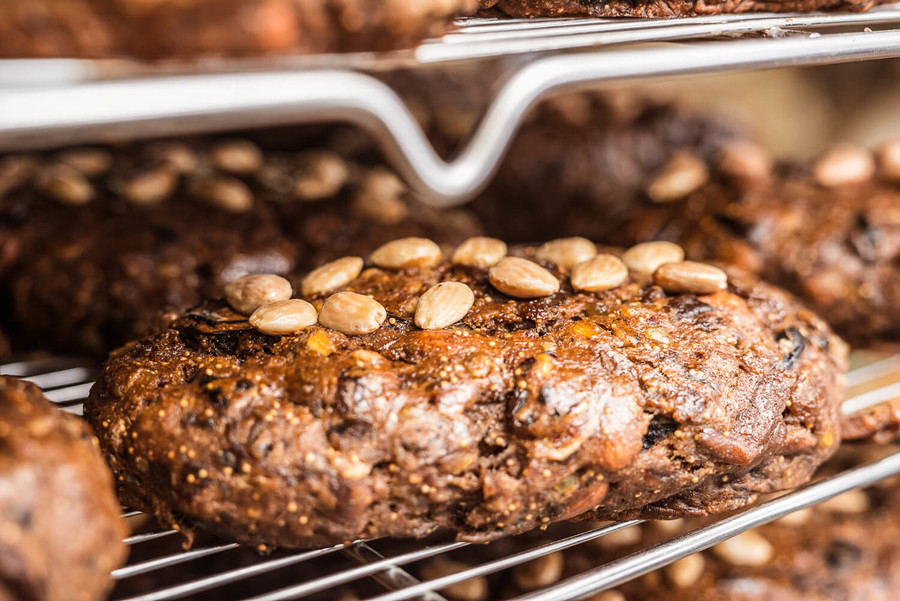
Hutzeln are the halved, dried fruits of an old pear variety, also called Hutzel pear. The term "hutzelig" means something like "wrinkled" in Swabia and thus aptly describes the appearance of the dried pears.
Ingredients
- 200g / 2/3 cup each of dried pears (Hutzeln), plums and figs
- 50g / ¼ cup dried apricots
- 100g / ½ cup raisins
- 200g / 1 1/3 cup chopped hazelnuts or chopped almonds
- 1 tablespoons Anise seeds
- 1 teaspoon ground cinnamon
- ¼ teaspoon ground cloves
- 2 tbsp freshly squeezed lemon juice
- 150g / 1 1/2 cups rye flour
- 150g / 1 cup + 2 tablespoons all purpose flour
- 5 teaspoons baking powder
- 6 eggs
- 250g / 1 cup granulated sugar
- Pulp of two vanilla pods or approximately 2 to 4 teaspoons of vanilla
Preparations
1. Soak the dried plums, pears and figs in water overnight (8 – 12 hours). Drain the fruit and roughly chop it. Finely dice the dried apricots. Put all the fruit with raisins, hazelnuts and almonds in a bowl, season with aniseed, cinnamon and cloves, drizzle with lemon juice and mix well.
2. Mix rye, all purpose flour and baking powder. Beat the eggs with the sugar until frothy. Add the pulp of the vanilla pods and the fruit and nut mixture. Finally, gradually knead in the flour mixture and knead the mixture well.
3. Shape the dough into two loaves of bread. Place on a greased baking sheet. Bake at 180 degrees Celsius / 350 degrees Fahrenheit for 70-80 minutes. After baking, let cool on a wire rack.
Dambedei
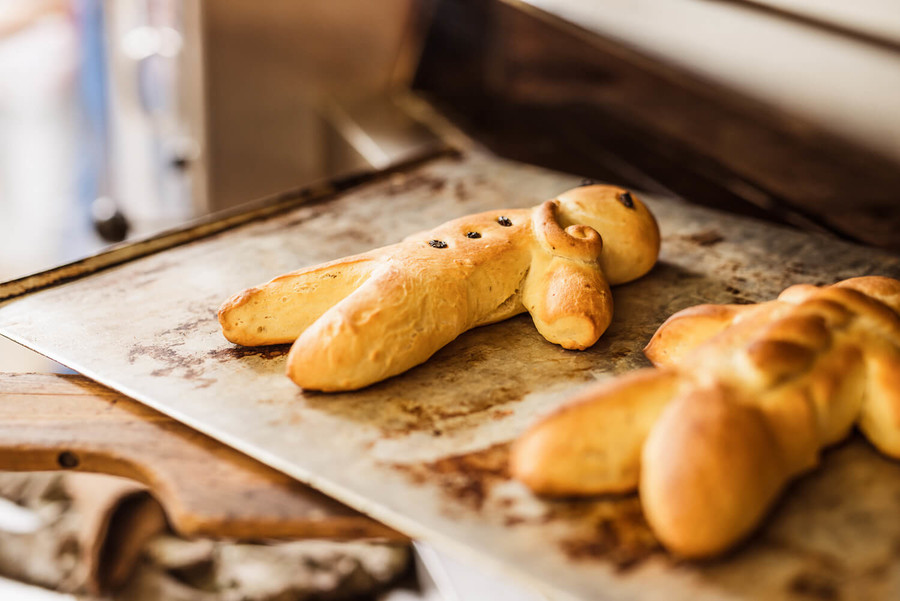
He is tanned and has many names: In North Baden and the Electoral Palatinate he is known as Dambedei, in South Baden as Grätti- or Baselmann and in other regions he comes across as Weck- or Klausenmann. But no matter what name he bears, every child recognizes it immediately by its characteristic appearance. With a pointed head, raisin eyes, almond mouth and the button placket made of nuts, the little yeast guy makes a real difference. The origin lies in church customs: people excluded from worship received blessed bread that was shaped like a man on the day of remembrance of Bishop Nikolaus von Myra.
Ingredients
- 300g / 1 1/3 cups all purpose flour
- ground lemon peel – lemon zest
- 200ml / 1 cup milk
- 2 tablespoons honey
- 20g / ¼ cup fresh yeast or 1 packet (2 ¼ teaspoons) active dry yeast
- 1/2 pod Bourbon vanilla (or 1 teaspoon vanilla extract)
- 2 tbsp rapeseed oil (canola oil)
- 1 egg yolk
- Raisins
Preparations
1. Mix wheat flour with lemon zest in a bowl. Warm the milk slightly, add honey and fresh yeast and stir. Slit half the vanilla pod lengthways, scrape out the pulp and add to the milk. Add milk and rapeseed/canola oil to the flour and mix with the dough hook of the hand mixer to form a soft dough, about 5 minutes. Let the dough rise to double its volume in a warm place, knead again by hand and roll out almost 1cm / 1/3 of an inch thick.
2. Cut out 4 Dambedeis/Cookies approx.20cm / eight inches long, place on two baking sheets lined with baking paper and brush with the egg yolk. Press the golden raisins into the dough as eyes and jacket buttons. Bake in the preheated oven for approx. 12 minutes at 200 degrees Celsius / 395 Fahrenheit.
Lebkuchen
Lebkuchen has a nice story in SouthWest Germany. Of course, everyone eats Lebkuchen in Germany (recipes vary from region to region) especially at the holiday time. What is interesting however is that there is a Lebkuchen trail in the Black Forest and it is part of the culinary tradition of a little village called Todtmoos. In the past, in addition to the bakers, it was the local women who earned extra income with Lebkuchen. The Todtmoos women baked the delicious and durable gingerbread in their home ovens and sold it at the pilgrimage stands next to the steep climb to the church. The so-called gingerbread women then bought hundreds of gingerbreads from the local bakers and brought them to the poor areas of the Black Forest. They were welcome there, because they brought the Christmas scent as well as the popular Christmas biscuits into the house.
Ingredients for dough (for approx. 45 pieces):
- ¾ cup = 12 tbsp honey
- 400g / 2 cups cane sugar
- 100g / 1 cup orange candied peel
- 60g / ¾ cup lemon candied peel
- 100g / 2/3 cup raisins
- 140g / 1 cup + 2 tablespoons chopped hazelnuts
- 500g / 5 cups wholemeal rye flour (type 1800)
- 300g / 2 ½ cups wholemeal spelt flour (type 630)
- 2 teaspoons of baking soda
- 20 g gingerbread spice (Lebkuchengewurz)
- 1 teaspoon cinnamon
- 1 teaspoon cloves (ground)
- 2 tablespoons cocoa powder
- 4 eggs (size L)
- 90g / 6 tablespoons + 1 teaspoon butter
- Juice and zest of an organic lemon
- For painting: 2 egg yolks, 3 tbsp milk
- For Decorating and Cutting: some whole peeled almonds and some cookie cutters (size 8cm)
Preparations
1. The day before for the gingerbread, heat the honey and cane sugar in a saucepan while stirring. Finely chop the orange peel, lemon peel, raisins and hazelnuts.
2. Mix rye and wholemeal spelt flour, baking soda, gingerbread spice, cinnamon, ground cloves, cocoa powder and the finely chopped orange peel, lemon peel, raisins and finely chopped hazelnuts in a bowl. Knead the heated honey with cane sugar, softened butter, lemon zest such as juice and eggs with the flour mixture until it is a very firm, brown dough.
3. Shape the dough into an elongated roll and leave to rest in a cold room overnight, airtight.
4. Preheat the oven to 160 degrees C / 320° F, line a baking sheet with baking paper.
5. Knead the dough well, roll it out on a floured work surface approx. 5 mm thick, cut out the gingerbread and place on the prepared baking sheet.
6. Mix the egg yolk and milk, brush the gingerbread cookies with the egg yolk and milk mixture, decorate with an almond and bake in the oven for about 15 minutes. 7. Place the baked gingerbread cookies on a wire rack to cool, store in a tin or container. The gingerbread is soft to eat after a day or two. However, they are better if they are stored longer, approx. 1-2 weeks.

